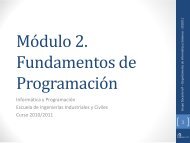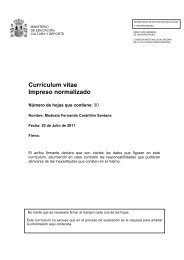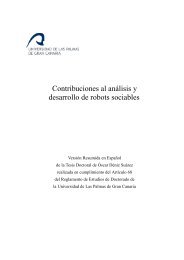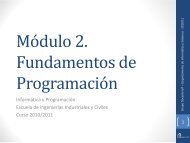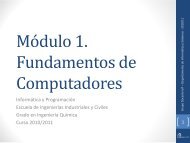PhD Document - Universidad de Las Palmas de Gran Canaria
PhD Document - Universidad de Las Palmas de Gran Canaria
PhD Document - Universidad de Las Palmas de Gran Canaria
Create successful ePaper yourself
Turn your PDF publications into a flip-book with our unique Google optimized e-Paper software.
CHAPTER 1. INTRODUCTION<br />
humanities. Every individual has a little amount of each component, and some individuals<br />
show preference for (or are more inclined to) a particular component. Problems appear when<br />
one of the components is not well <strong>de</strong>veloped.<br />
All these findings suggest that social intelligence aspects must be addressed if we are<br />
to build robots that imitate human intelligence. What is more, social intelligence could be<br />
even more important than other capacities. There is evi<strong>de</strong>nce that in primates social intel-<br />
ligence is one important prerrequisite for the evolution of non-social, domain-in<strong>de</strong>pen<strong>de</strong>nt<br />
intelligence [Dautenhahn, 1995]. As an example, the highly elaborated ability of symboliza-<br />
tion is suggested to be a social act of agreeing [Bullock, 1983]. Some authors contend that<br />
social intelligence is also necessary for the <strong>de</strong>velopment of generic intelligence in humans,<br />
see [Lindblom and Ziemke, 2003]. This ’Social Situatedness Hypothesis’ (also known as<br />
Machiavellian Intelligence Hypothesis) emphasizes the importance of <strong>de</strong>signing and build-<br />
ing robots that can interact with other agents. In this respect, the work of Brooks already<br />
showed the importance and benefits of this approach [Brooks, 1991].<br />
This document <strong>de</strong>scribes the experiences, i<strong>de</strong>as and techniques involved in building<br />
CASIMIRO 1 , a robot with basic social abilities. CASIMIRO is a robotic head that inclu<strong>de</strong>s<br />
facial features and neck movements. The robot was not <strong>de</strong>signed for performing a certain<br />
precise task. If any, its task would be to interact with humans (note the vagueness of that).<br />
At some point in the <strong>de</strong>velopment process the option of restricting the robot’s behaviour to<br />
a game or entertaining task was consi<strong>de</strong>red, although that was always discar<strong>de</strong>d. For some<br />
members of our group (including me) this produced at times a feeling that the robot would<br />
end up doing anything. When I have that sort of horror vacui feeling, I think in babies. They<br />
do not seem to be doing anything, although they already have some physical and mental<br />
capabilities that are unattainable for a machine.<br />
1.1 Previous Work<br />
In or<strong>de</strong>r to provi<strong>de</strong> the rea<strong>de</strong>r with a more practical viewpoint on social robotics, in this<br />
section a brief <strong>de</strong>scription of the most influential social robots built is given. Not all of such<br />
robots appear here. Being an emergent field, their number seem to increase on a monthly<br />
basis. This section is intentionally short, as other robots will be referenced and <strong>de</strong>scribed in<br />
the rest of the document.<br />
The following three major application areas can now be distinguished for interaction<br />
1 The name is an Spanish acronym of "expressive face and basic visual processing for an interactive robot"<br />
4




